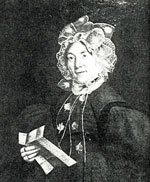|
by Stefan Bielinski
"Jane" married Abraham C. Cuyler in the Albany Dutch Church in April 1764. The first of her five children was baptized there the following June. Janet Cuyler had been a pewholder at the Dutch church since 1759. The new family settled into a comfortable house on North Pearl Street where Abraham prospered as a merchant/trader who became more and more closely allied with the royal government of New York. After serving in several municipal offices, he was appointed mayor of Albany in 1770. However, the upward arc of this traditional early Albany family was ruined by the conflict with the British. In 1776, Mayor Cuyler was arrested, banished, and finally found his way to British-occupied New York City. Without her husband, Janet and her young children fell back on both families - both of whom were closely connected to the revolutionaries. But, by the end of 1777, she was able to take her children to join Abraham in New York. Her ordeal was similar to that endured by a number of Albany women whose only crime was that they were guilty by association. Their story is examined further elsewhere on this website. With the end of the war, these Cuylers initially returned to Albany but decided emigrate to Canada where many American loyalists went to begin a new life. Janet Glen Cuyler survived the death of her husband in 1810. Sometime later, she was buried beside Abraham C. Cuyler in Yorkfield, Canada.
Portrait by an unknown artist now hangs in "Cuyler Manor," a house museum and country estate at Port Elizabeth (Uitenhage), South Africa. This copy is from the Afrikans language Het Geslacht Kuilart by J. W. Schaap and H. H. J. Kuilart (South Africa, 1984), 25. Nicoll, Earliest Cuylers, 32, holds that the portraits were derived from sketches made by John Andre in 1776.
|
